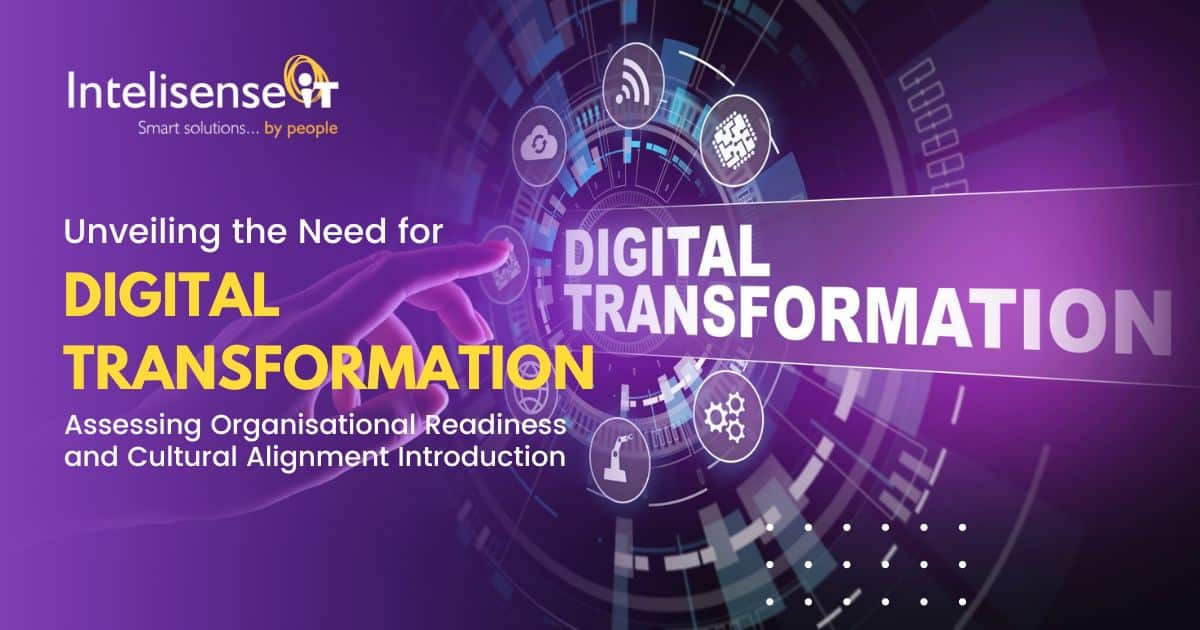Unveiling the Need for Digital Transformation: Assessing Organisational Readiness and Cultural Alignment Introduction
In today’s rapidly evolving business landscape, characterised by technological advancements and increasing customer expectations, digital transformation has become a vital strategy for organisations to remain competitive and future-proof. The journey toward digitalisation is not merely about adopting new technologies but requires a fundamental shift in the organisation’s mindset and culture. However, not every business is ready to embark on this transformative path.
This article aims to provide a comprehensive plan to identify whether a business should consider a digital transformation and explores the significance of organisational culture in successfully implementing such changes.
Understanding the Digital Transformation Landscape
- Definition and Scope of Digital Transformation
Digital transformation refers to the strategic adoption of digital technologies and the integration of digital capabilities into all aspects of an organisation’s operations and business models. It encompasses leveraging data, automation, artificial intelligence, cloud computing, and other emerging technologies to drive efficiency, innovation, and customer-centricity. The impact of digital transformation extends across various dimensions, including enhanced operational efficiency, optimised supply chains, personalised customer experiences, data-driven decision-making, and the ability to seize new market opportunities.
- Conducting an Industry Analysis
An in-depth industry landscape analysis is crucial to understanding the digital trends and disruptions shaping the competitive landscape. Organisations must identify emerging technologies, changing customer preferences, and market dynamics that are driving the need for digital transformation. By evaluating the degree of digitisation in the industry, businesses can gauge their position relative to competitors and comprehend the potential consequences of failing to adapt to the evolving digital landscape.
Assessing Business Readiness for Digital Transformation
- SWOT Analysis for Digital Transformation
Conducting a comprehensive SWOT analysis tailored specifically to digital-transformation will provide a clear picture of the organisation’s current state. Identify the strengths that can be leveraged, weaknesses that need to be addressed, opportunities that can be capitalised on, and potential threats that may hinder progress.
This analysis will help organisations understand their competitive advantages, assess their vulnerabilities, and identify areas where digitalisation can bring about substantial improvements.
- Evaluating Technological Infrastructure
Assess the organisation’s existing technological capabilities and infrastructure to determine their readiness for digital transformation initiatives. Consider factors such as the compatibility of current systems with new technologies, scalability, data security, and the need for upgrades or investments. Having a robust technological foundation is essential for successful digital-transformation, as it supports the seamless integration of new digital tools and platforms into existing operations.
- Analysing Data and Analytics Maturity
Data and analytics are the bedrock of digital transformation, enabling data-driven decision-making and enhanced customer experiences. Evaluate the organisation’s data governance practices, data collection, storage, and analytical capabilities. A mature data and analytics ecosystem allows organisations to extract valuable insights, predict trends, and personalise services, thereby driving better business outcomes.
- Assessing Employee Skills and Talent
The success of digital transformation largely depends on the expertise and digital skills of the workforce. Evaluate the current skill sets within the organisation and identify gaps that may hinder the adoption and implementation of digital technologies. Investing in upskilling or hiring digitally proficient talent will be crucial in bridging these gaps and creating a workforce equipped to embrace digital-transformation.
Assessing Organisational Culture for Digital Transformation
- Leadership Buy-In and Support
Strong leadership commitment is critical for driving and sustaining digital-transformation initiatives. Assess the level of support from top-level executives and their active involvement in championing the change. Effective leadership will provide the necessary resources, guidance, and vision to inspire the workforce and navigate the challenges that come with transformative change.
- Embracing Change Management
Evaluate the organisation’s history of handling change and its adaptability to new ideas and technologies. A culture of innovation, adaptability, and openness to change will significantly influence the success of digital-transformation. Identify potential barriers or resistance to change and devise strategies to address them through effective change management practices.
- Promoting Collaboration and Communication
Digital-transformation often requires breaking down silos and fostering a culture of cross-functional collaboration. Analyse the existing communication channels and collaboration processes within the organisation. A collaborative culture encourages knowledge sharing, creativity, and agility, facilitating the smooth integration of digital technologies and enabling innovation.
- Emphasising Customer-Centricity
Assess the organisation’s focus on understanding and meeting customer needs. A customer-centric culture is vital in driving digital-transformation, as it instils a strong commitment to delivering exceptional customer experiences. Evaluate the organisation’s willingness to adopt new technologies and customer-centric approaches that enhance interactions and relationships with customers.
Making the Decision
- Weighting Factors for Assessment
Assign appropriate weightage to each of the identified readiness factors based on their relevance and impact on the organisation’s digital-transformation journey.
Understanding the relative importance of these factors will help prioritise efforts and resources to address areas that require attention.
- Developing a Decision Matrix
Create a decision matrix incorporating each readiness factor’s weighted assessment. The decision matrix will provide a comprehensive view of the organisation’s overall readiness for digital transformation. Based on the scores obtained, leaders can decide whether to proceed with digital transformation initiatives.
Conclusion
Digital transformation holds immense potential for organisations seeking to thrive in an ever-changing business landscape. However, it is crucial to recognise that successful digital-transformation goes beyond implementing new technologies; it requires evaluating the organisation’s readiness and fostering a culture that embraces change, innovation, and customer-centricity.
By following the outlined plan to assess business readiness and evaluating the organisational culture, businesses can make informed decisions about their digital-transformation journey. A well-aligned culture will serve as a catalyst for driving digital-transformation initiatives forward and maximising the benefits of digitalisation. Embracing digital-transformation is not an option but an imperative for organisations aspiring to succeed and stay relevant in the digital age.
If you are keen on delving further into how you can be supported on your digital-transformation journey, reach out to the expert team at Intelisense IT. They’ve created and delivered many Digital-Transformation Consultancy Workshops which are tailored to guide you through the process, regardless of which stage you are in currently. Found out more details here




